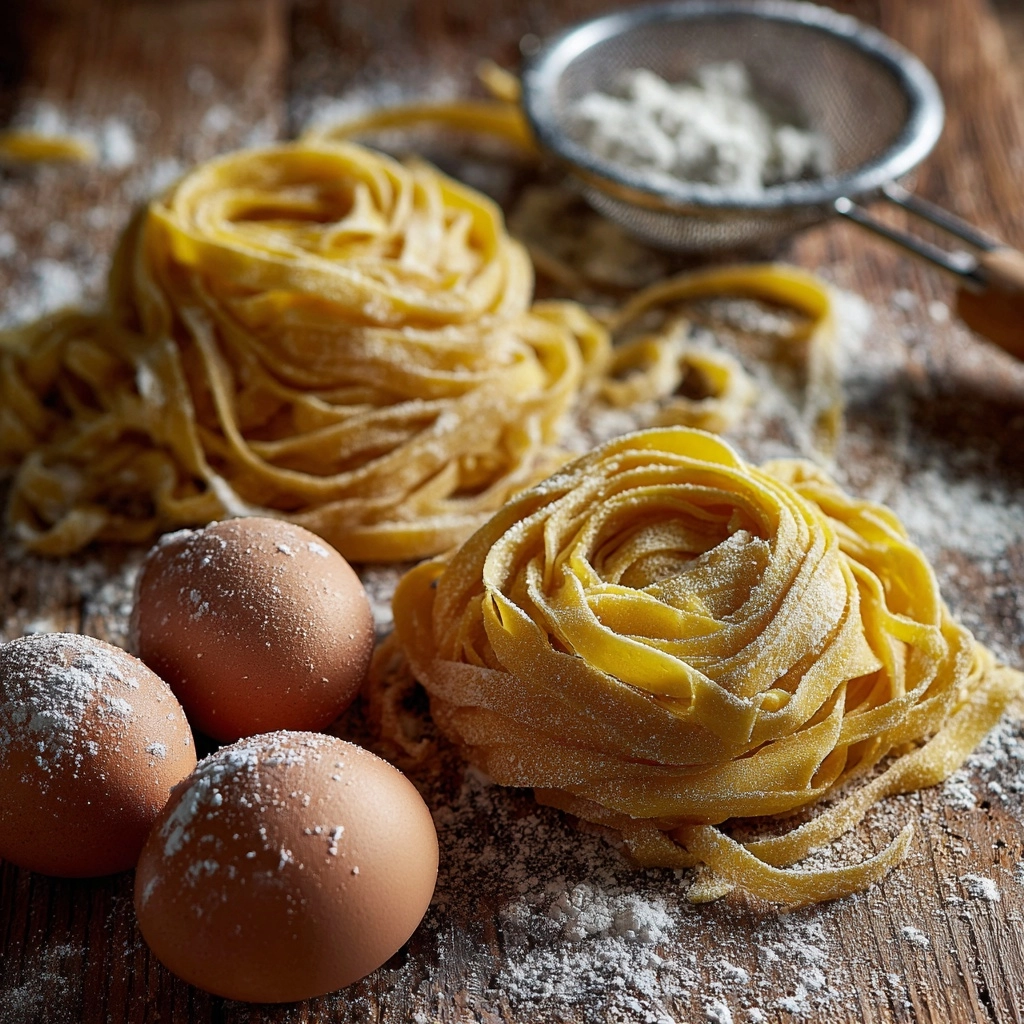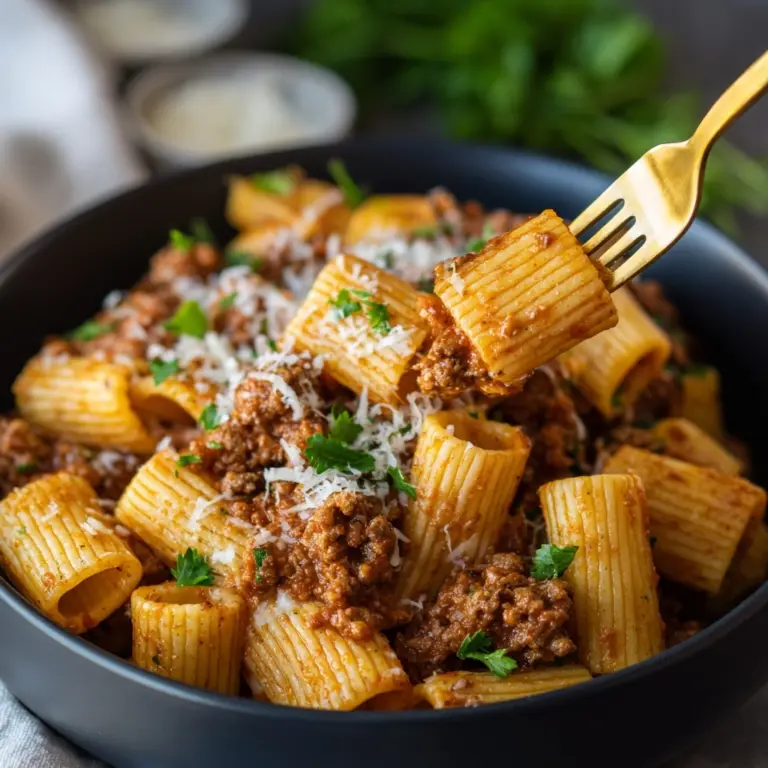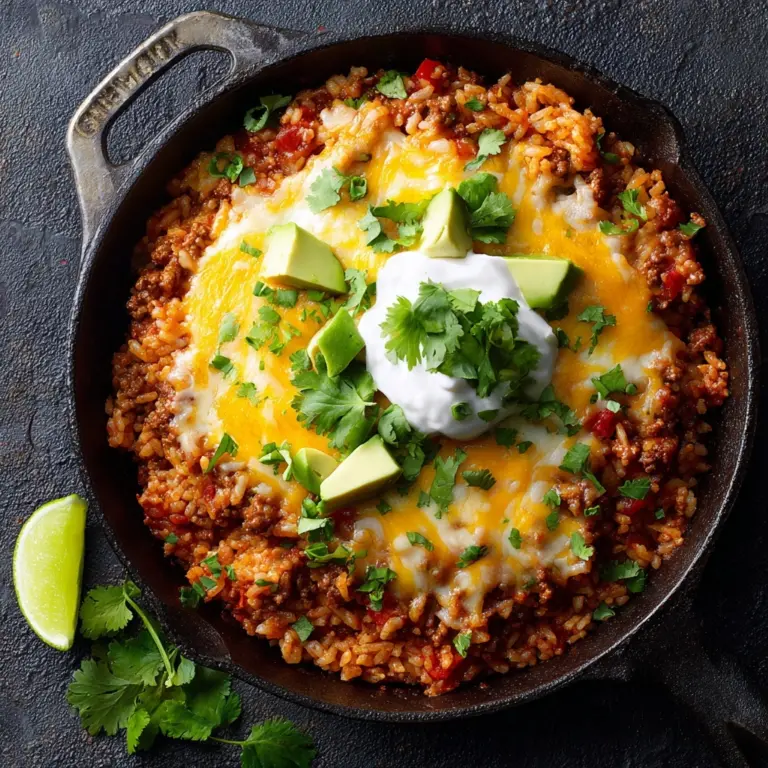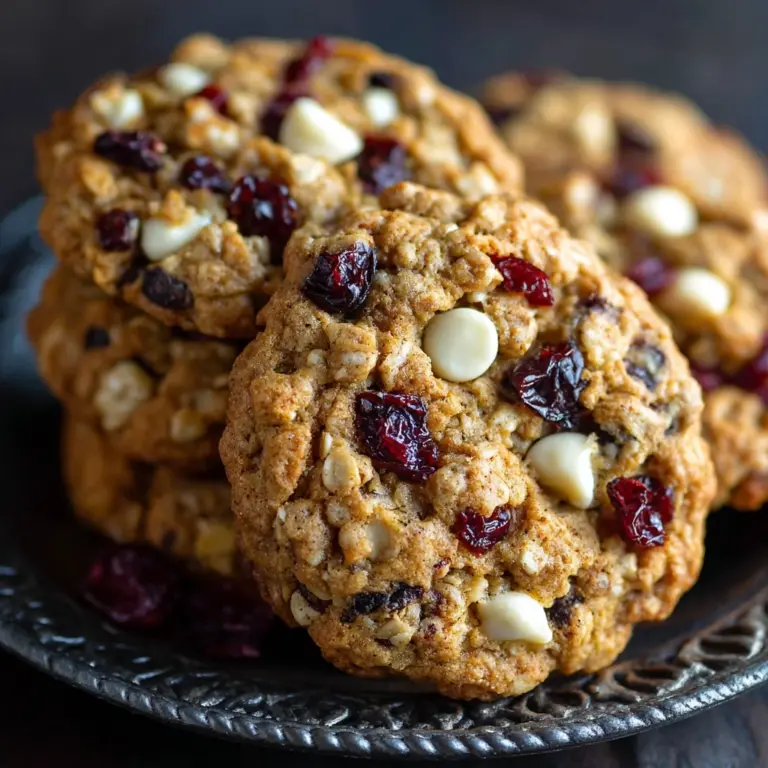If you’ve ever dreamed of twirling a forkful of tender, golden strands that you made with your own two hands, then you’re in for a real treat with this Homemade Pasta. There’s something almost magical about working simple ingredients into a dough and watching it transform into ribbons of silky, fresh pasta. The process is surprisingly approachable, endlessly satisfying, and the flavor is in a league of its own compared to anything you’d find in a box. Whether you’re a total beginner or a pasta enthusiast, this recipe will have you whipping up your own delicious noodles in no time.
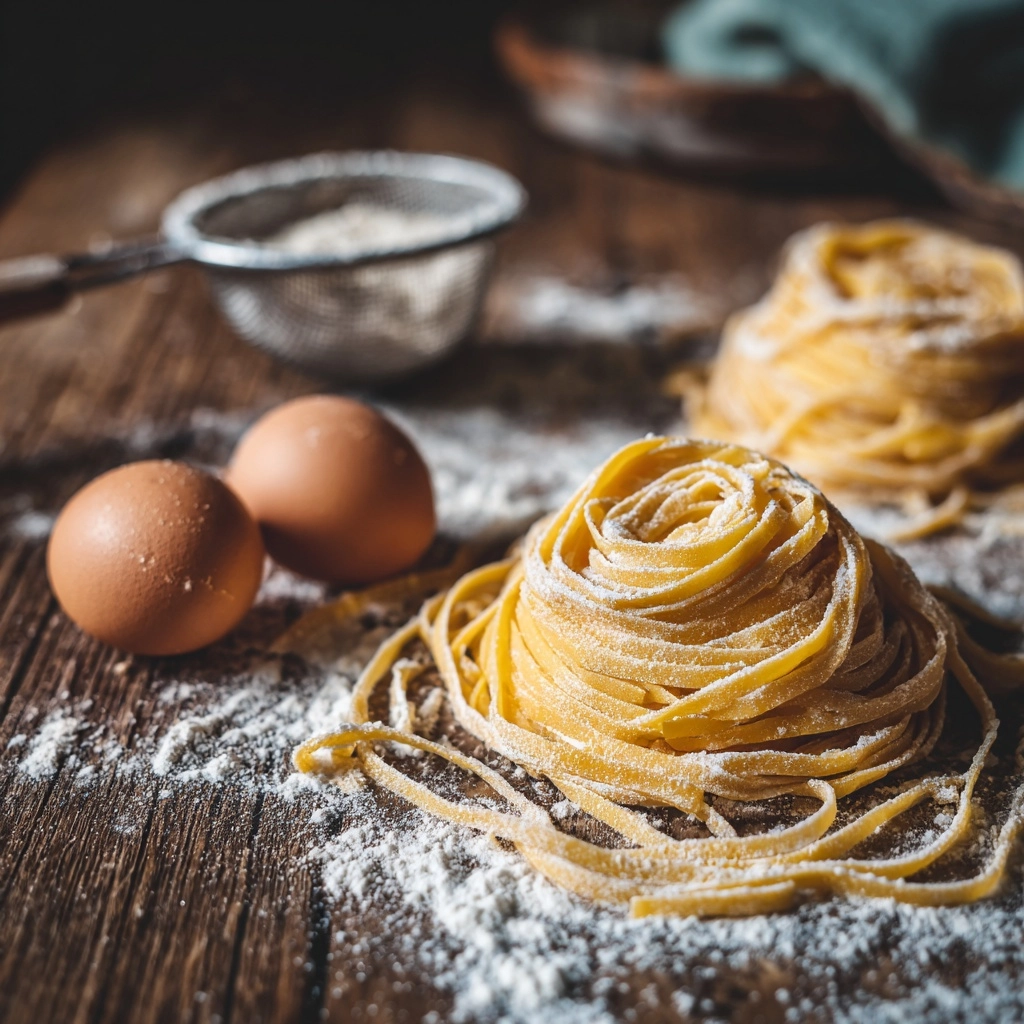
Ingredients You’ll Need
With just a handful of pantry staples, you can create Homemade Pasta that feels like a true Italian celebration. Each ingredient brings something special to the table, whether it’s richness, color, or that perfect bite. Here’s what you’ll need and why:
- All-purpose flour: Reliable and easy to work with, this flour gives your pasta a tender yet sturdy texture that’s perfect for a variety of shapes.
- Large eggs: The star of the show, eggs add richness, beautiful color, and strength to your dough.
- Olive oil: Just a splash lends a subtle flavor and keeps your dough supple and easy to roll out.
- Salt: Enhances the overall flavor of the pasta and helps bring all the ingredients together.
- Extra flour for dusting: Essential for keeping your dough from sticking as you roll and cut your Homemade Pasta.
How to Make Homemade Pasta
Step 1: Make Your Flour Well
Start by mounding your flour on a clean work surface. Use your hands or the bottom of a measuring cup to create a deep well in the center. This classic Italian technique keeps your eggs contained as you mix, and it sets you up for pasta-making success.
Step 2: Add Eggs, Olive Oil, and Salt
Crack your eggs right into the well, then drizzle in the olive oil and sprinkle over the salt. These ingredients will come together to form a rich, flavorful dough that’s the backbone of your Homemade Pasta.
Step 3: Incorporate the Flour
Using a fork, gently whisk the eggs, gradually drawing in flour from the edges of the well. Take it slow to avoid breaking the walls and making a mess. As the mixture thickens, start folding in more flour with your hands until a shaggy dough forms.
Step 4: Knead the Dough
Now for the fun part: kneading! Use the heels of your hands to work the dough for about 8 to 10 minutes, until it becomes smooth and elastic. If it feels sticky, sprinkle on a little more flour as needed. This step develops gluten, giving your pasta its irresistible chew.
Step 5: Let the Dough Rest
Wrap your dough in plastic wrap and let it rest at room temperature for 30 minutes. This rest period relaxes the gluten, making the dough much easier to roll out and shape later on.
Step 6: Roll and Shape Your Pasta
Divide the dough into quarters and work with one piece at a time, keeping the rest wrapped to prevent drying. Roll each portion out using a pasta machine or a rolling pin until you reach your desired thickness. Then, cut it into your favorite shape—fettuccine, tagliatelle, or anything your heart desires. Don’t forget to dust the noodles with flour to keep them from sticking together!
Step 7: Cook to Perfection
Bring a large pot of salted water to a rolling boil. Drop in your fresh pasta and cook for just 2 to 4 minutes, until al dente. Fresh Homemade Pasta cooks much faster than dried, so keep an eye on it! Drain well and get ready to serve with your favorite sauce.
How to Serve Homemade Pasta
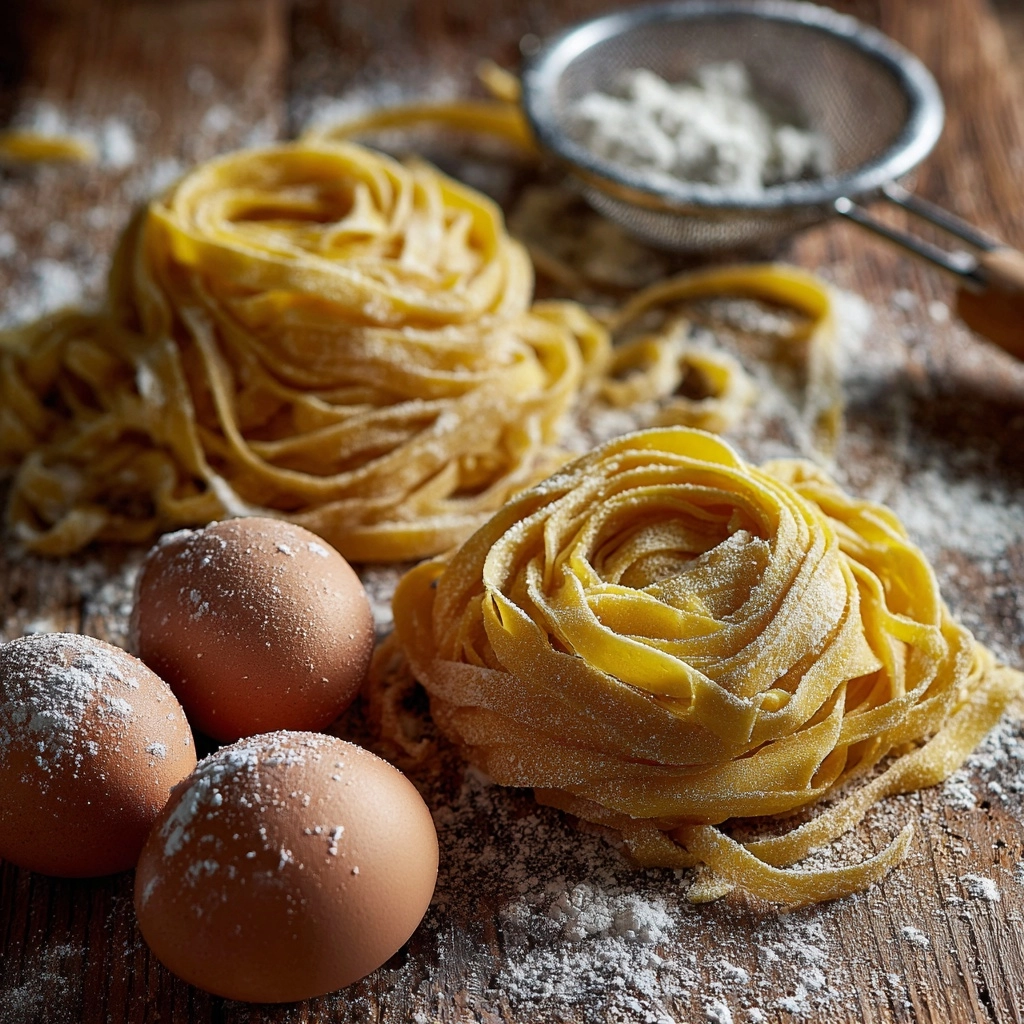
Garnishes
Elevate your bowl of pasta with classic garnishes. A generous shower of freshly grated Parmesan, a sprinkle of chopped fresh basil or parsley, and a drizzle of good olive oil make any Homemade Pasta shine. Add a twist of cracked black pepper for a little kick, or a touch of lemon zest for freshness.
Side Dishes
For a complete Italian-inspired meal, pair your pasta with a crisp green salad tossed in a tangy vinaigrette or a platter of roasted vegetables. Warm, crusty bread is perfect for mopping up every last bit of sauce, and a glass of wine never hurts either!
Creative Ways to Present
If you’re feeling festive, twirl small nests of Homemade Pasta onto plates for an elegant restaurant-style presentation. For family-style dining, pile the noodles high in a big serving bowl and let everyone dig in. You can even color your pasta with natural ingredients like spinach or beet puree for a playful, colorful twist.
Make Ahead and Storage
Storing Leftovers
If you have extra Homemade Pasta, let it cool completely before transferring to an airtight container. Refrigerate for up to 3 days. The texture holds up beautifully, and it makes for a fabulous quick meal later in the week.
Freezing
Homemade Pasta freezes like a dream! Lay the cut noodles out in a single layer on a floured baking sheet and freeze until solid, then transfer to a freezer bag. Store for up to 2 months. When you’re ready to enjoy, cook straight from frozen—just add an extra minute or two to the cooking time.
Reheating
To reheat cooked pasta, place it in a colander and dip it into boiling water for 30 seconds to 1 minute, just until warmed through. Alternatively, toss it directly into a hot skillet with a splash of your favorite sauce for a quick and tasty refresh.
FAQs
Can I use only egg yolks for a richer pasta?
Absolutely! Substituting one of the eggs with two yolks makes your Homemade Pasta even silkier and richer, with a gorgeous golden hue. It’s a little indulgent but totally worth it.
What if I don’t have a pasta machine?
No problem! A rolling pin and a little elbow grease are all you need. Roll the dough as thin as possible and use a sharp knife or pizza cutter to slice into your favorite shapes.
Is semolina flour necessary?
Not at all, but it can add a firmer, slightly chewier texture to your Homemade Pasta. Feel free to swap in some or all semolina if you want to experiment with texture and flavor.
How do I prevent the pasta from sticking together?
Dust your noodles generously with flour as you cut them and toss them gently to coat. This keeps the strands separate and makes cooking a breeze.
Can I make the dough ahead of time?
Yes! You can prepare the dough and keep it wrapped in the fridge for up to 24 hours before rolling and shaping. Just let it come to room temperature before working with it for best results.
Final Thoughts
There’s truly nothing like the joy of making and sharing Homemade Pasta from scratch. Once you’ve tasted the difference, you may never go back to store-bought noodles. So gather your ingredients, roll up your sleeves, and treat yourself (and your loved ones) to a bowl of pure, homemade comfort. Happy pasta making!
Print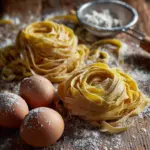
Homemade Pasta Recipe
- Prep Time: 45 minutes
- Cook Time: 5 minutes
- Total Time: 50 minutes
- Yield: 4 servings
- Category: Main Course
- Method: Stovetop
- Cuisine: Italian
- Diet: Vegetarian
Description
This homemade pasta recipe delivers fresh, tender egg pasta made from scratch using simple ingredients like all-purpose flour, eggs, olive oil, and salt. With step-by-step instructions for kneading, resting, rolling, and cutting the dough into your desired shapes, you can enjoy authentic Italian pasta on your stovetop in under an hour.
Ingredients
Dry Ingredients
- 2 cups all-purpose flour
- 1/2 teaspoon salt
- Extra flour for dusting
Wet Ingredients
- 3 large eggs
- 1 tablespoon olive oil
Instructions
- Prepare the dough mixture: Place the flour on a clean work surface and make a well in the center. Crack the eggs into the well, add the olive oil and salt. Using a fork, gently whisk the eggs, gradually incorporating the flour from the edges until a dough begins to form.
- Knead the dough: Knead the dough for about 8–10 minutes until smooth and elastic. This develops the gluten for a perfect pasta texture.
- Rest the dough: Wrap the dough in plastic wrap and let it rest at room temperature for 30 minutes to allow the gluten to relax, making rolling easier.
- Divide and roll: Once rested, divide the dough into quarters. Roll out each portion using a pasta machine or rolling pin to your desired thickness for your choice of pasta shape.
- Cut pasta shapes: Cut the rolled dough into your preferred shapes such as fettuccine or tagliatelle. Dust with flour to prevent sticking.
- Cook the pasta: Bring a large pot of salted water to boil. Cook the pasta for 2–4 minutes until al dente. Drain and serve with your favorite sauce.
Notes
- For a richer dough, substitute one whole egg with two egg yolks to increase yolk richness and flavor.
- Semolina flour can be used in place of some or all of the all-purpose flour to achieve a firmer texture.
Nutrition
- Serving Size: 1 cup cooked pasta
- Calories: 280
- Sugar: 1g
- Sodium: 160mg
- Fat: 6g
- Saturated Fat: 1.5g
- Unsaturated Fat: 3.5g
- Trans Fat: 0g
- Carbohydrates: 45g
- Fiber: 2g
- Protein: 10g
- Cholesterol: 140mg

